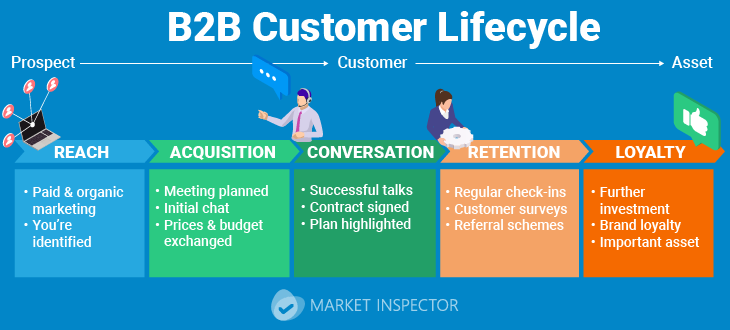- Market-Inspector.co.uk
- Blog
- Business to Business Customer Experience: Complete 2024 Guide
B2B Customer Experience: Complete 2024 Guide

What is B2B experience?
B2B stands for business to business, it’s essentially the transaction between businesses. An example of a B2B service would be the relationship between a wholesaler and a retailer. This differs from business to consumer (B2C) which is between a business and an individual.
In B2B there is a supply chain, the example I’ll give is a furniture shop. That shop orders its stock from a manufacturer, that manufacturer would’ve ordered materials from another business to make that piece of furniture. So multiple B2B dealings were required to allow that B2C transaction to take place.
A good B2B customer strategy can lead to big success for businesses, with Meltwater revealing that 86% of buyers are willing to pay more for a good customer experience. On the opposite end of the scale, one-third of buyers said they’d consider dropping a company altogether after just one bad experience.
Benefits of a good B2B experience:
- Good reputation: Working with other businesses is a great way of developing a positive reputation for yourself and the business you represent. If someone is happy with your work then they’re more likely to talk about you on their website and social media. This can be very beneficial to the recruitment side of your business, potential candidates will hear about your company because of your reputation.
- More referrals: A good reputation links to more referrals. If you do a good job for one company, they might refer another to you. This cuts out potential advertising and marketing costs you’d need to attract new clients. More business gives you more power when it comes to pricing, which ultimately increases your profits.
- Speeds up delivery: Having a good B2B process in place when it comes to factors like communication can impact delivery speed. If all parties are clear on what they are doing and when it needs to be done then this should make for a very efficient relationship. Businesses can often misunderstand each other, which leads to disagreements and delays. This is frustrating and costly for both, so avoiding this is crucial for a successful partnership.
- Cost efficient: Keeping the clients you already have is considerably cheaper than searching for new ones. By maintaining a good relationship you will save resources in the long run.
- Strong relationships: Having strong relationships with external businesses is crucial for success. If you’re trusted, you might be the first in line for discounts or offers which will increase your return on investment. It also allows support during difficult times, those with strong relationships with manufacturers or suppliers are more likely to ride through things like recessions.
Six tips to improve B2B Customer Service
1. Clear communication
As mentioned above, clear communication can speed up delivery and improve overall performance. Give your clients contact information for yourself and colleagues so they always have someone on hand during working hours. Slow replies to emails or messages can be frustrating, so make sure to respond promptly.
Keep your clients informed on the work you’ve been doing, as silence may lead them to think you’re not prioritising them. Give them a weekly report (perhaps every Friday) on what has been completed this week. Make it easy for them to access spreadsheets and other information that shows results.
Something a lot of businesses are guilty of is not championing their work. Businesses will get some fantastic results for their clients, but won’t sing and dance about it. Let your clients know you’ve done this, be enthusiastic and this will leave a positive impact.
2. Realistic expectations
Before you take on a new client or start working with a business make sure you mutually agree on expectations. Many relationships break down due to businesses overpromising in their pitch. Agree on realistic targets before any contracts are signed, this will prevent parties from feeling disappointed.
3. Regular catch-ups
It’s important to stay in verbal contact with clients regularly, even if it’s an informal chat about how things are. The Conversation Space revealed that only 7% of the impact of what we say comes from the words themselves, 55% from body language and 38% from tone of voice.
Set up a weekly or bi-weekly meeting to catch up on how things are going and to make sure both parties are on the same page. It can be hard to understand someone in writing, so you’ll find clients might be more assured by words directly from your mouth.
4. Understand them
Understanding another business can be tricky, some industries like tech might seem like another language. Go on their website and take a thorough read, and make some notes that you can look down on when on calls. Showing a good knowledge of your client’s business will only serve you well and make you look good.
Not just the business, but understanding the person you are talking to day to day. This might be the owner, CEO or head of department. Take an interest in them as a person, what their experience is and what they get up to at the weekend. This makes conversations more personal and allows you to build a good relationship. It is however important not to overstep the mark, as being overly personal could have the opposite effect.
5. Be flexible
All good businesses have procedures in place for their employees, these are guidelines that ensure that the correct process is followed. However, if a client makes a request which would need to bend these procedures, don’t immediately shut them down. If it’s possible, being flexible will leave a great impression, as they can see you’re making a real effort to accommodate their needs. This will make your client feel more valued, and a valued client is a happy client.
6. Legal assurances
When drafting a contract, make sure that it is thorough and fair to both parties. A poorly drafted contract can lead to big problems, so it’s important to protect both sides' interests.
B2B Customer lifecycle
A business-to-business customer cycle (or B2B customer journey) is typically made up of five stages; Reach, Acquisition, Conversion, Retention and Loyalty.

Reach: This is the stage where the potential customer has identified they need to invest in a certain area of their business, and are currently deliberating. They would have identified you from either your good SEO ranking, social media marketing and other methods. You will know when you’ve successfully passed this stage when the customer contacts you for prices and further information.
Acquisition: When you set up a call with the customer, this is the acquisition phase. This is an initial chat about what they are looking for and whether you can offer it to them. You will answer any questions they might have, and then ask them questions to get more insight into their business. A good website will make this process easier, they will be able to research your company and the fees that you charge to ensure you aren’t wasting each other's time.
Conversion: The talks have gone well, and they’ve signed the contract and are now officially your customer. Here you might want to show them the calendar you’ve created highlighting what activity you’re going to be doing relating to them over the next six-months to a year. You should never let your guard down, as now it’s all about retention, retention, retention.
Retention: Keep checking in with the customer, make sure that they are happy with the service you are providing. Schedule regular meetings to ensure this, and always flag any concerns you may have. Send out customer surveys which will give you a better understanding of where you’re going right and wrong. Offer referral schemes if they are satisfied with your performance, this could bring you more customers and increase your revenue.Loyalty: The customer might now be looking to invest more money into the same thing, due to the good relationship you’ve built they will choose you. You’ve made them feel like a valued customer and feel a sense of loyalty towards you and your business. Due to your hard work over the previous four stages, you’ve created strong brand loyalty which makes this customer one of your most important assets.
How to deliver a good B2B sales experience?
Don’t be ‘pushy’
Persistence is important when it comes to sales, however, there’s a fine line between that and being pushy. Pushy comes across as desperate or that you’re trying to scam the person you’re pitching to, it can seriously damage your personal and business reputation.
B2B sales often contain more money, the person you are trying to sell to needs to completely trust you. Just the slightest red flag might be enough for them to take their money elsewhere. You aim to build a long-lasting relationship, not just to flog them something. Give them a gentle nudge, for example, ‘If you’re interested we ideally need to know by the end of the day on Friday, take some time to think and let us know if you have any questions’.
Be clear
Make sure that your pitch is clear when delivering to a client. Think about what questions they’d ask and make sure you’ve either answered it in your pitch or have prepared an answer. If something is confusing, or you can’t answer then this might lose you the sale.
Speak clearly and be easy to understand, don’t feel offended if a potential customer asks you to repeat what you’ve said. It’s common for internet connections to drop and for parts to be missed so it’s crucial you make sure that you get every point across.
Listen
Before you’ve even got on a call with a client, take a good look at what they’ve said to you. In their initial conversation, they’ll often give several hints as to what they are looking for. Take this onboard with your planning as this can link to you being more flexible for them as a client. During the sales pitch, listen to the feedback they give. This will help you when it comes to performance later down the line. Note down their expectations so both parties are on the same wavelength.
Ask questions
Another thing to take into account before you start the call is what you want to find out about them. Write down bullet points of the key information you need to know and tick them off once you find out. Then at the end, you can look down and see if there are any key questions you need to ask. One of the biggest regrets for businesses when meeting clients is forgetting to ask them crucial questions.
If they answer every point you have noted down, still make sure to ask questions anyway. This will make you look engaged in the conversation, it will show you care for their business and want as much information to do as good a job as possible.
Fast process
According to a Forbes article, 52% of B2B buyers say the buying cycle for new purchases has gotten longer. So stand out from your competitors by making the process quick and easy for any onboarding clients. Eliminate inefficient meetings and bring in protocols that will increase speed during selling. This will benefit the client, but will also benefit your business as you’ll find yourself with more time to tackle other tasks.
Be multi-channel
Some industries can be very competitive to the point that it is intimidating for those looking to pick between competitors. Give your business the best chance by diversifying the platforms you use to attract new business opportunities. Examples include; Social media platforms, LinkedIn, Paid Media, Traditional Public Relations, TV, Radio, Thought Leadership, Webinars and email.
We strive to connect our customers with the right product and supplier. Would you like to be part of Market Inspector?

